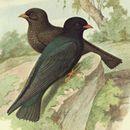Biology
(
englanti
)
tarjonnut Arkive
Usually observed in flocks, the African river-martin's flight is rapid with moments of gliding. It can feed while flying, snatching flying ants (their primary food) from the air, and it also feeds on butterflies, moths, beetles, bugs and termites (2). Like many swallows, the African river-martin migrates, moving between two breeding areas; the Democratic Republic of Congo, and the coastal areas of Gabon and Congo (2) (5). However, it is not known if the same bird breeds at both sites, or if the non-breeding season is spent at one of them (2).
Eggs and nestlings of the African river-martin have been recorded in February and March in the Democratic Republic of Congo, while breeding activities have been observed between September and November in Gabon and Congo. The river-martin nests in colonies of up to 800 birds, laying a clutch of three eggs into a hole situated in a sandbar in a river, in a grassy sand-ridge near the coast, or in a slope of the coastal plain. It often digs its own burrow, extending around 150 centimetres, or sometimes uses the existing burrow of a bee-eater (2).
Conservation
(
englanti
)
tarjonnut Arkive
The African river-martin is assessed as Data Deficient on the IUCN Red List, meaning that there is insufficient information available to assess this species risk of extinction (1). Therefore, the most important action needed is to undertake further research so that the conservation status of this African swallow can be determined.
Description
(
englanti
)
tarjonnut Arkive
The African river-martin, the most primitive living swallow (3), has blue-black or purple-black plumage with an attractive green sheen to the back, and sooty brown under-wings. Its tail is black and square, the feet are brownish-pink, and the red eye is surrounded by a pink eyering (2). Like other swallows, the African river-martin's large, orange-red bill can open wide, enabling the bird to catch insects while flying with ease (2) (4). Male and female African river-martins are the same in appearance while juveniles have dull sooty brown plumage (2).
Habitat
(
englanti
)
tarjonnut Arkive
The African river-martin breeds along forested rivers, in coastal savanna and on islands with sandy shores. Outside of the breeding season it can be found roosting in reedbeds or in vegetation along rivers. The African river-martin has also been recorded roosting on buildings (2) (5).
Range
(
englanti
)
tarjonnut Arkive
Occurs in Gabon, Congo and the Democratic Republic of Congo (2)
Status
(
englanti
)
tarjonnut Arkive
Classified as Data Deficient (DD) by the IUCN Red List 2007 (1).
Threats
(
englanti
)
tarjonnut Arkive
While the African river-martin occurs in large numbers on its breeding grounds, it may be facing a number of threats. In the Democratic Republic of Congo, large numbers of adults and nestlings are taken for food by local people and this hunting pressure is believed to be increasing. Breeding colonies in river sandbars are also vulnerable to flooding (2) (5).

